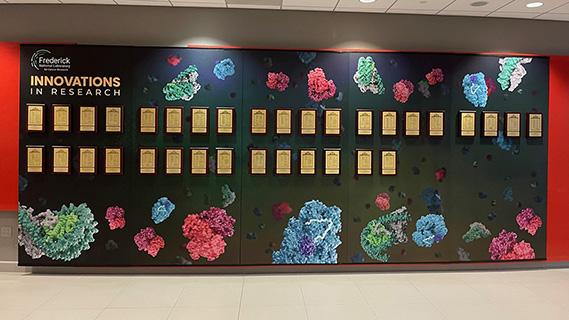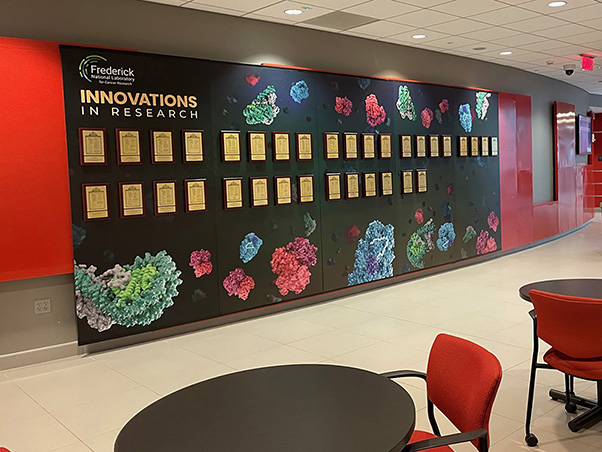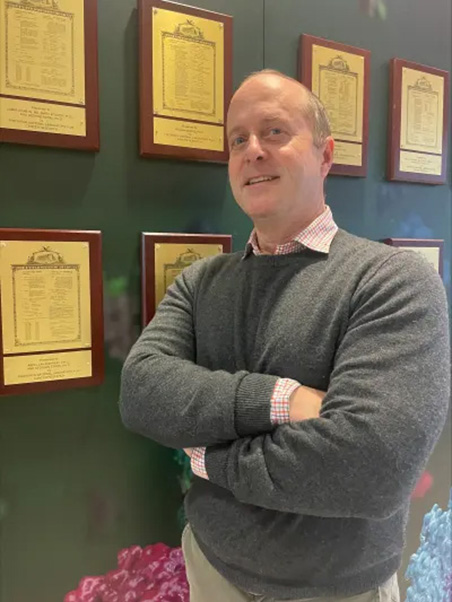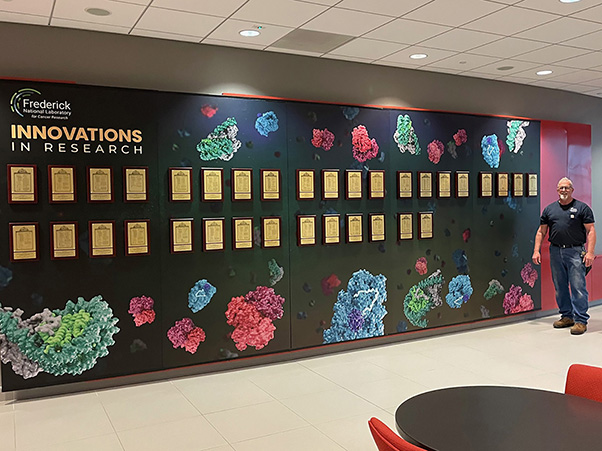The Frederick National Laboratory for Cancer Research (FNL) has a new installation: a wall featuring 34 plaques highlighting patents granted to FNL researchers in recognition of their inventions and the breakthrough work being done at the laboratory. The “Innovations in Research” wall represents the mission of FNL staff to address some of the most urgent challenges in the biomedical sciences.
At the end of December 2023, the Center for Innovation and Strategic Partnerships installed the wall to honor scientific contributions and inspire other scientists at the FNL. The wall is adorned with plaques that showcase who was on the patent, what they invented, if there were any partners, and more. Additional patents will be added to the wall as new FNL patents are granted.
Some FNL patents that have been used to develop novel therapies and research tools for cancer and cancer-causing viruses were fueled by partnerships. These collaborations brought together different backgrounds, viewpoints, and expertise that led to the innovation’s success. There were also numerous individuals who may not be listed on the plaques but still worked in the laboratory to help drive an invention’s success. What they all have in common is the extensive work involved in developing the patents. Below, we describe the efforts behind a few of the inventions featured on the plaque wall.
Alternate Perspectives Drive Success
Stephan Stern, Ph.D., the co-director of FNL’s Nanotechnology Characterization Laboratory, recently developed a novel pancreatic cancer therapeutic with Jill Smith, M.D., of Georgetown University.
To do this, they aimed to halt the production of the gastrin protein, which stimulates cancer growth through a loop, in which cancer cells produce and respond to their growth factors—leading to further cancer growth. Given that the relative five-year survival rate of pancreatic cancer is 12.8 percent, there is a large need for improved treatment.
While some inventions are developed by unexpected discoveries, Smith and Stern knew exactly what they wanted to accomplish and how they would get there. They began developing this therapy by seeking to target the receptor for the hormone gastrin, which Smith had identified as being more present in pancreatic cancer.
To target the cancer and prevent the production of gastrin, they formulated a class of charged molecules condensed with small interfering RNA (double-stranded RNA molecules that prevent the expression of certain genes). This could home in on the cancer and prevent its spread.
After conducting several studies, they revealed that they had been able to stop the progression of pre-cancerous disease, as well as halt the growth and spread of existing tumors in animal models.
Upon reflection, Stern noted that the patent’s success would not have been possible without the collaboration. Stern’s team is made up of experts in nanomedicine formulation and characterization, whereas Smith is a medical doctor and cancer researcher who provided both clinical and disease insights.
“She has an understanding of the cancer biology and the alternate perspective on what’s important to the doctor down the road. … It’s been a great collaboration that way,” said Stern.
Proving a Drug’s Success
Denise Whitby, Ph.D., the principal investigator in the Viral Oncology Section of the AIDS and Cancer Virus Program, was a co-inventor for a Kaposi’s sarcoma (KS) therapy, part of an effort led by Robert Yarchoan, M.D., of the National Cancer Institute’s HIV and AIDS Malignancy Branch. KS is a cancer that people living with HIV are often at the highest risk of developing.
“[The therapy] involves a drug called pomalidomide and was the first new treatment for KS to be approved by the FDA in 25 years,” said Whitby.
Whitby’s laboratory provided some of the data essential for the therapy’s development. Using a quantitative polymerase chain reaction assay, a test that estimates the amount of genetic material in a sample, her team measured the amount of KS-associated herpesvirus (KSHV)—the virus that causes KS—in the blood of people with KS.
“We were able to show that [the] KSHV viral load was reduced or even became undetectable in patients treated with pomalidomide,” said Whitby.
The drug development effort consisted of eight clinicians and scientists who brought a diverse range of expertise to the table, ultimately leading to a therapy fully approved by the Food and Drug Administration.
Whitby also noted that “all good science involves collaboration and teamwork. Innovation is often nurtured by bringing together scientists with different skills and perspectives.”
Preventing Indefinite Cancer Growth
Apurva Srivastava, Ph.D., a senior principal scientist in the FNL’s Applied and Developmental Research Directorate, studies the biochemical and physical effects of drugs to demonstrate that a drug is engaging with the intended target.
“We develop novel detection reagents (in this case an antibody that specifically binds a drug target) that are used in developing pharmacodynamic [PD] assays. This invention is the result of such effort,” said Srivastava. PD assays study the biochemical effects of drugs.
He and his group helped invent a new PD test that can determine whether the activity of a protein that is linked to tumor cell growth is lessened after binding to a drug in tumor tissue. The invention only binds to the protein when it’s active, which also helps to show whether the target protein is causing the cancer cells to grow.
“In the application that we validated, the biomarker assay reports the magnitude of target activation and reports if a drug caused target suppression,” explained Srivastava.
The tool has already affected the clinical field. Srivastava and his team were able to demonstrate that a specific investigational agent, in advanced stages of development (Phase II and III clinical trials), was not engaging or inhibiting the intended target. Thanks to the invention, the NCI Division of Cancer Treatment and Diagnosis stopped seven clinical trials, saving time and money and—most importantly—saving patients from undergoing an ineffective therapy.
“It was gratifying that something we developed as part of our routine research has a wider impact, which is [also] evident from interest from pharmaceutical or commercial vendors,” said Srivastava.
Innovations that Inspire
Next time you come by the FNL’s Advanced Technology Research Facility, make sure to stop by the “Innovations in Research” wall, located in the atrium, to see these patents and many more. With the new installation coming soon, the wall will continue to showcase many accomplishments of FNL scientists and the impact they have had in their field.
Mira Deni was a Werner H. Kirsten Intern in the Partnership Development Office (PDO) at the Frederick National Laboratory for Cancer Research (FNL). She wrote articles, created communications materials, researched partners/performance measures, and more. PDO establishes partnerships with FNL and industry, academia, and other research institutions.
Teaser image: The plaques provide information on the inventors, field of invention, publications, partners, and more. (Photo credit: Lyuba Khavrutskii)






